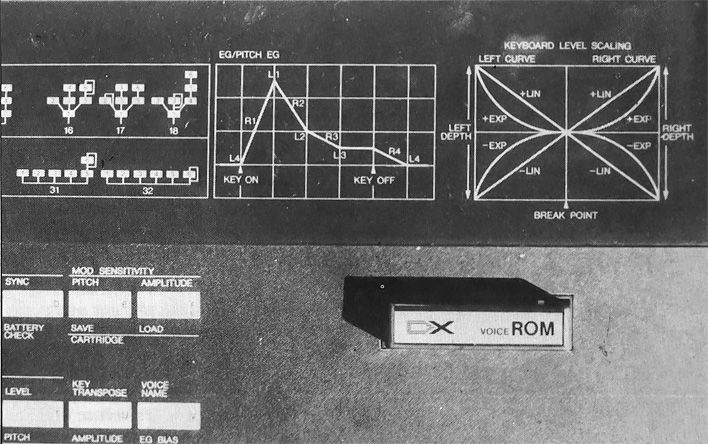The Yamaha DX7 Envelope Generator, part one.

Silence, sine waves and trigonometry.
The Yamaha DX7, an FM synthesizer released in 1983, should need little or no introduction. Its sound can be heard throghout most of mid-to-late 1980s music.
If you’re new to FM synthesis, I’d suggest reading Chowning’s paper that introduced the concept: it’s a fascinating and inspiring read.
The DX7 has six operators. Each operator is an oscillator with two inputs (amplitude and pitch), with the output sine wave modulated by a per-operator envelope. The fundamental operation of FM synthesis consist in using the output of an operator to modulate the pitch of another (or itself, referred to as feedback). An additional global envelope modulates the pitch of the note being played.
The basic operation of FM synthesis: one operator (Modulator) modulates the pitch of a second operator (Carrier) that produces sound. ( Source )
A DX7 voice, or instrument, specifies each operator’s (relative or absolute) pitch and amplitude, and defines how they’re connected to each other, and which operator’s output becomes sound. There are other parameters, but the fundamental characteristic of a voice is defined by the parameters above.
The Yamaha DX7 can hold 32 voices. It is possible to create and use new ones – it’s a programmable synthesizer after all – and the never disappointing Internet has many new voices available for download.
The preset voices (that range from Piano, to Marimba, to Bass) show how flexible this synthesizer is. It is in the nature of curious people, then, to look at each voice and see how they’re made. These are not samples after all, the operators synthesize these complex sounds from silence, sine waves and trigonometry!
This is precisely the beauty of FM synthesis: its theory and basic implementation are simple, and few lines of code produce powerful and unexpected results.
Analysing a DX7 voice.
In order to look at voices, we need to fetch them and look at their internals.
Both operations are quite easy. You can instruct the synthesizer to
dump all 32 voices in bulk over MIDI and in Linux you can easily save
them using amidi --receive. The format is quite simple, and well
specified in the DX7 manuals.
Understanding how those parameters translate in physical characteristic is a bit more complicated.
The DX7 operator configuration is mostly in settings that go from 0 to 99, and understanding how these translate into sound production (pitch, amplitude) requires some fair amount of reverse engineering.
The operators connections (algorithms) and the frequency at which they operate are well known and easy to understand.
What’s hard, and yet fundamental for characterising a FM sound, is understanding the parameters of the envelope generators.
Understanding envelopes.
As already said, there are seven envelope generators in a DX7 voice. Six for each operators, modulating amplitude, and one global, modulating the pitch.
An envelope in a DX7 has four segments. Three for attack (start of note to sustain) and one for the decay (end of sustain to end of sound). Each of these segments are configured by two paramenters, level and rate. Level (0-99) is the amplitude reached by the segment, rate (also 0-99) specifies how fast it will get there.

A DX7 envelope scheme as printed on the synthesizer itself. ( Source )
At this point a lot of question arise, some make sense, some might not.
- What kind of curve has each segment? (linear, exponential, other)
- How level progress from zero to maximum? (linear, exponential, other)
- How rate progress from zero to maximum? (linear, exponential, other)
- How level (amplitude) is interpreted when used to modulate frequency of another operator? I.e., what amplitude is required to modulate the operator frequency by 1 Hz?
In order to get these answers, we’ll have to look at waves.
Part two is here
